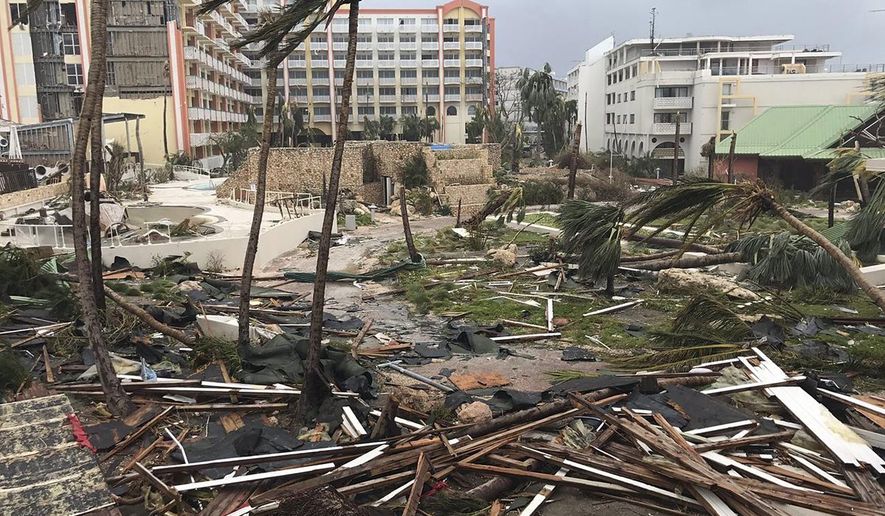MIAMI (AP) - Hurricane Irma turned its deafening winds and punishing downpours toward Florida on Friday after strafing the Caribbean . The Sunshine State issued mandatory evacuations and was bracing for impact as the storm barreled toward the U.S. mainland.
Irma had maximum sustained winds of 150 mph (240 kph) by midday Friday. It is forecast to remain at Category 4 strength when it comes ashore someplace south of Miami on Sunday.
___
WHAT’S AHEAD FOR IRMA?
The National Hurricane Center in Miami says hurricane conditions are expected in parts of South Florida and the Keys on Saturday night or early Sunday.
The center says the upper Florida Keys and into southeast Florida should expect rain accumulations of 10 to 15 inches through Tuesday night. Eastern Florida into coastal Georgia will likely see 8 to 12 inches, with isolated spots getting up to 16 inches. Life-threatening flash floods and mudslides in some areas were possible. Normally dry areas near the coast could be flooded due to the combination of dangerous storm surge and tide, the center said.
The water could reach 6 to 12 feet above ground from Captiva to Cape Sable in southwest Florida if peak surge occurs at high tide.
___
WHAT HAS IRMA DONE SO FAR?
The death toll in the Caribbean stood at at least 21 and was expected to rise as rescuers reached some of the hardest-hit areas. And a new danger lay on the horizon to the east: Hurricane Jose, a Category 4 storm with 150 mph winds that could punish some of the devastated areas all over again.
In Barbuda, where 90 percent of the buildings were severely damaged by Hurricane Irma, the government was encouraging residents to evacuate to the sister island of Antigua ahead of Jose.
About a million people were without power in Puerto Rico, which was spared a direct hit as Irma passed to the north.
___
EVACUATION TRAFFIC JAMS
Miami Mayor Carlos Gimenez says more than 660,000 residents of Miami-Dade County must evacuate and find hurricane-proof shelters as Irma bears down on Florida. The county plans to open 43 shelters with room for more than 100,000 people by Friday night.
Across Florida and Georgia, about 1.4 million people were ordered to leave their homes, clogging interstates as far away as Atlanta.
___
IRMA VS. ANDREW
In 1992, Hurricane Andrew became the costliest hurricane in U.S. history with damages of $26.5 billion (about $50 billion in current dollars). Irma is expected to far exceed that. Experts say Irma will strike lots more people and buildings.
Both Andrew and Irma started as wisps of unstable weather off Africa. Andrew was an unusually compact major storm that roared east-to-west almost in a straight line and hit just south of Miami’s core. Andrew’s swath of destruction was narrow, and it moved straight out of South Florida at relatively high speeds of about 18 mph (29 kph).
But the National Hurricane Center’s forecast path for Irma is from the south, hitting Miami and perhaps its highly developed and expensive central region, then up through affluent Broward and Palm Beach counties and further north, threatening the entire peninsula instead of just its tip.
___
TEST FOR FLORIDA’S BUILDING CODES
A catastrophic Hurricane Andrew revealed how lax building codes had become in the country’s most storm-prone state. Florida responded by requiring sturdier construction. Now, experts say a monstrously strong Hurricane Irma could become the most serious test of Florida’s storm-worthiness since the 1992 disaster.
___
FINANCIAL MARKETS
Stock markets in Asia traded in narrow ranges Friday as sentiment was kept in check partially over worries about Hurricane Irma. Japan’s benchmark Nikkei 225 closed lower, as did Australia’s S&P/ASX 200 and South Korea’s Kospi. In Hong Kong, however, the Hang Seng moved up.
___
PRESIDENT TRUMP’S RESORT
Hurricane Irma is likely to test President Donald Trump’s Mar-a-Lago mansion. But strikes by four previous hurricanes did little damage to the facility in the 90 years since cereal heiress Marjorie Merriweather Post and her second husband, financier E.F. Hutton, built the 126-room, 62,500-square foot (5,800-square meter) estate in Palm Beach. The mansion’s walls are 3-feet (1 meter) thick, anchored by steel and concrete beams embedded into coral rock.
___
HURRICANE NEWSLETTER - Get the best of the AP’s all-formats reporting on Irma and Harvey in your inbox. https://apne.ws/ahYQGtb




Please read our comment policy before commenting.